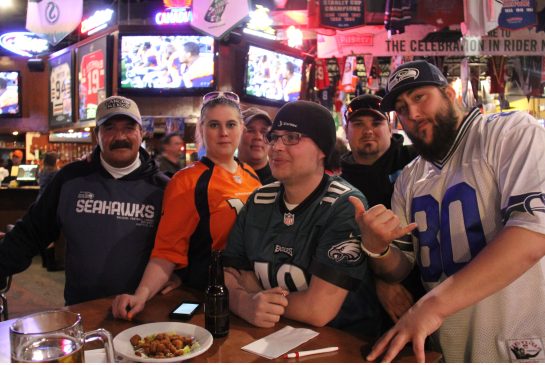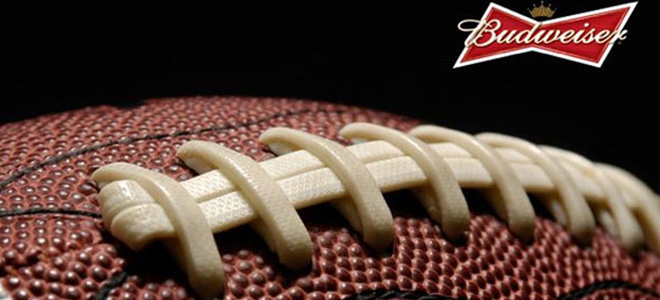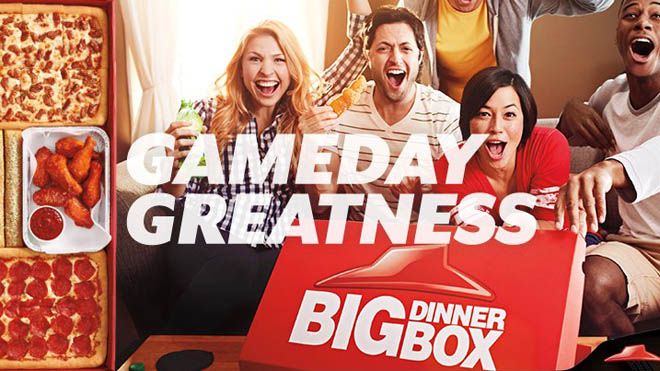Superbowl Commercials and Sponsorship Influence
Superbowl television broadcasts in recent years have ranged between 90.7 to 120.8 millions viewers. Substantial audiences are a fantastic opportunity for sponsorship explosure. This is done through a mixture of establishing a connection with audiences and providing notable entertainment. There has been analysis of the ‘cross-pollination’ potential of commercialism when being used across different subjects or events such as the televised Superbowl game and its commercials 1. This article will explore how these interconnected effects take place and their results. In context of the Superbowl, commercials are crafted to immerse audiences into the sponsor’s products; thus showcasing the large amount of influence sponsors have on the event. Once a sponsor has paid for commercial time during the Superbowl broadcast, they are able to market their products specifically for Superbowl audiences.

How Sponsors influence Superbowl Commercials
Budweiser is a major sponsor for the Superbowl, owning profits of $22.3 million this year and is one of America’s most recognisable brands 2. The Superbowl takes advantage of Budweiser on a commercial and interactive basis. Their audiences, a percentage of whom congregate in sports bars, have the ability to purchase a Budweiser. Budweiser and Superbowl’s partnership reflects ‘sponsorship dollars, plus accompanying marketing clout and expertise, have elevated many events in terms of size and quality’. 3

This is shown in the above Budweiser advertisement where Jay Z partakes in Superbowl predictions for a Budweiser. This commercial’s context reflects various points regarding the Superbowl’s commercial power. Jay Z’s appearance generates audiences’ attention, due to his celebrity stature. Budweiser‘s Superbowl narrative is another factor in making audiences notice their product. Budweiser’s sponsorship money uses Jay Z as a personification for their product and the ability to make it memorable, so that audiences are aware of the possibility to purchase a Budweiser.
Cinema is a vastly popular medium in American society. Statics show that over two-thirds of the American population visit the cinema at least once in the last year 4. Since the Superbowl’s viewing figures reach hundreds of millions, it is an ideal opportunity for cinematic commercials to be broadcast during Superbowl breaks. The connection of cinema as a popular medium and opportunities within Superbowl marketing as ‘advertising that audiences love’ 5. Although the Star Trek commercial makes no Superbowl references, its broadcast reflects how important movie studios see the Superbowl for promoting new releases, due to the audiences’ relation to cinema.

Like Budweiser, Pizza Hut is a major Superbowl sponsor using its commercial power to maximize profit. Pizza Hut has been expanding globally over recent years 6, which helps regarding sales during the Superbowl. Since Superbowl audiences 7 immerse themselves into enjoying the game, ordering takeout food is a possibility. The commercial is set in a living room with friends enjoying the Superbowl with a pizza. They are be-raided by Rex Ryan, head coach for Buffalo Bills, demanding their pizzas should be better. As with the Budweiser advertisement, Pizza Hut is using a notable celebrity to promote their product in order to gain audiences’ interest. Once this has been achieved, then the intention is to make their commercial memorable to strengthen the possibility of maximizing profits.

When Sponsorship Marketing Clashes With The Superbowl
There are certain rules which commercials follow within Superbowl marketing. As the Superbowl is acceptable for all ages, any explicit content is discouraged. Commercialism’s primary aim is to convince consumers to purchase products. Sponsors need to appeal towards consumers seen in the argument that ‘commercialisation of culture, and the associated culturalisation of the economy’, 8 making sure commercials are relatable. The Skittles commercial is indiscreet regarding its presentation, showing a newly wed couple having sex. Replacing semen with skittles is the commercial’s attempt to make their product memorable. Although this may be a smart decision in commercial terms, it cannot be acceptable for the Superbowl due to its universal appeal. This reverts back to commercialising culture and its associating culturalisation, as the Superbowl is accessible for all ages meaning that no explicit content is acceptable.
This is a SodaStream commercial in its original form was deemed unacceptable. This is due to Scarlett Johansson’s closing remarks “sorry Coke and Pepsi”. This is a direct challenge to other major Superbowl sponsors, which forced SodaStream to edit Johansson’s closing remarks. This reflects another aspect of commercialism, where sponsorship money has vast control over commercial content. Sponsors who place themselves within the Superbowl broadcast do so in order to make their product superior. Sponsors do not want their products to be challenged or openly ridiculed. Sponsors cannot forge a interconnection between their products and audiences, if the latter feels it is not a worthwhile purchase.
The examples shown throughout this article reflect the vast commerce influencing Superbowl marketing. Sponsorship money increases Superbowl finances along with styling their commercials to influence audiences, in order to potentially maximise their profits. Superbowl tailor this relationship with sponsors for multiple purposes. Besides from the need to make profits from their products, it also offers vast exposure. If a particular sponsor builds a reputation within the Superbowl, then they are able to expand themselves into similar events. Budweiser is a major sponsor at other sporting events, making it a familiar brand for all sports fans. Yet as displayed in some commercials, there are rules which must be respected. Any explicit content or direct challenges to fellow sponsors destroys any interconnected effects seeked through audiences and damages potential profits.
Works Cited
- Dashper., K., eds. 2015. Sports Events, Society and Culture. Routledge. ↩
- http://www.forbes.com/companies/budweiser/ ↩
- Hudson., S. 2012. Sport and Adventure Tourism. The Haworth Hospitality Press. ↩
- http://www.mpaa.org/wp-content/uploads/2015/03/MPAA-Theatrical-Market-Statistics-2014.pdf ↩
- Schultz., B. 2015. Sports Media: Reporting, Producing, and Planning. Focal Press. ↩
- http://www.yum.com/annualreport/ ↩
- Brym., R and Lie., J. 2012. Sociology: Pop Culture to Social Structure (3rd Edition). Wadsworth. ↩
- Andrews., D.L. 2006. Sport – Commerce and Culture: Essays on Sport in Late Capitalist America. Peter Lang Publishing. ↩
What do you think? Leave a comment.











Nice timing for this article as we enter into the infamous season of Super Bowl. Looking forward to The Mayhem guy!
It’s incredibly interesting how different generations respond to different forms of marketing.
That’s why it’s so imperative for companies to be cognizant of what methods work best for the demographics and audiences that they are trying to reach.
One of the distinguishing features of Super Bowl commercials is that they are produced with an exceptionally high level of professionalism from a creative perspective.
Last years Super Bowl commercials were extremely controversial and talked about in news and media platforms for weeks. The most recognized one of them being the Nationwide safety commercial about the dead boy.
The Super Bowl is a gigantic marketing event.
I completely agree!
The Super Bowl has developed into far more than a football game.
I could be wrong about this, but I thought I heard about this PETA Super Bowl commercial that was banned for being too risque.
I wonder how long the Super Bowl will be this popular, though? From what I hear, football is on the decline, and enthusiasm might wane in the coming years.
It’s one of the year’s biggest events and advertisers know it’s a chance to make a serious impression.
This is an interesting article! I had no idea that the Soda Stream commercial was unacceptable because it challenged other sponsors. I also had no idea that sponsors like Pizza Hut made so much money!
The Super Bowl is a brand of marketing all its own. With all the insane ads aired during the game, companies definitely do use all sorts of tactics to garner attention, it was interesting to see the article focus on celebrity sponsorships. With all the attention paid to which brand produces the craziest ad, I definitely see what Skittles was going for, but that ad is totally not family friendly.
Advertisers make special efforts in the creation of ads for this event.
Interesting commentary on corporate propaganda and advertisement.
Superbowl 50 commercials were honestly not funny. It is crazy how much they spend to make the commercials.
Advertising itself is everywhere and there is no way to get away from it. Since advertising has made itself an aspect of the Superbowl, has it become the ‘norm’ of what’s expected when watching the Superbowl? There are many people who actually look forward to seeing what advertising companies have put together for that year.
Sponsors can make a big impact on the super bowl commercials because they are essentially like the big donors and they can control who they donate and who they support so their voices and their influences are strong and steady.
Good essay, interesting about SodaStream.
I know that Super Bowl ratings in the years since this article’s publication have gone down. Food for thought.